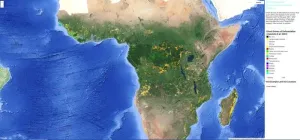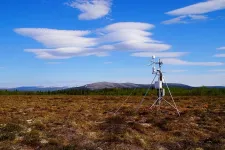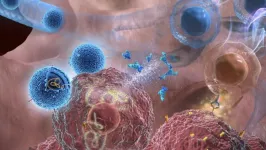(Press-News.org) Upending the prevailing theory of how and why multi-species mass-migration patterns occur in Serengeti National Park, researchers from Wake Forest University have confirmed that the millions-strong wildebeest population pushes zebra herds along in competition for the most nutrient-dense grasses.
The study resulting from this research, “Interplay of competition and facilitation in grazing succession by migrant Serengeti herbivores,” appears today in the peer-reviewed journal Science.
For decades, biologists have believed the major grazing populations in Serengeti – zebra, then wildebeest and then Thomson’s gazelle – each cleared the way for the smaller herbivores that followed, facilitating their access to the plants they preferred.
This study paints a different picture of the Serengeti landscape. Based on the largest and most comprehensive data analysis to date, it is the first study to combine information from camera traps, GPS collars on individual animals, diet analysis and satellites that track the effects fires and rainfall have on the grassland.
The research team, led by Wake Forest University Professor of Biology T. Michael Anderson, demonstrates that wildebeest and zebra compete for the best parts of the tall grasses that cover Serengeti. Once those two grazing populations move on, the gazelle then can access the flowering plants and shrubs that grow beneath the grass cover.
“Zebra are essentially bulk feeders. They require a large amount of vegetation in order to meet their energy demands,” explained Anderson, the study’s principal investigator and corresponding author. “If they stayed behind the wildebeest, the wildebeest would just consume all the vegetation and the zebra wouldn't be able to meet those energy demands.
“That observation was novel, and we call it the push-pull hypothesis for grazing succession. Instead of facilitation, it's competition on the front end.”
The zebra population is around 200,000 strong in Serengeti, whereas the wildebeest top 1.3 million.
“It’s like an enormous lawn mower,” Anderson said. “They have a huge effect on the grass biomass.”
Serengeti is the perfect setting for such a study. Because many of the multi-species mass migrations on the planet have been eliminated, the movement of the zebra, wildebeest and gazelle is unique.
Typically, three factors can influence herbivore mass-migration patterns: competition for food; facilitation, or the act of one species improving the foraging opportunities for another; and predation, where the grazing animals form mixed herds to avoid being eaten.
Competition influences the larger of the Serengeti species migration, but facilitation does come into play. While the wildebeest push the zebra in competition for food, the larger species make it easier for the gazelle to reach those rare forbs, or flowering plants, that offer them the most nutrition. Later in the season, the gazelle switch to eating the young grasses that are regrowing in the wake of the zebra and wildebeest grazing.
Anderson said the findings in Serengeti have application across the globe, where scientists are trying to restore the vast grasslands where plants and animals co-evolved. As Serengeti still functions the way it did hundreds of thousands of years ago, its management can help inform projects such as American Prairie.
“If we're going to learn to manage these ecosystems in the face of global climate change and increasing anthropogenic effects, we are going to have to learn from these mechanisms,” he said.
The study was funded through grants from National Geographic Society, National Science Foundation, European Union Horizon 2020 program, Frankfurt Zoological Society and British Ecological Society.
The research team included Staci Hepler, Robert J. Erhardt and Robert Sketch of the Wake Forest University Department of Statistical Sciences, as well as Jeffrey Muday of the biology department.
Anderson and Hepler, one of the project’s statisticians, both said the collaboration between the departments led to much stronger results after the data analysis. Understanding the biology, Hepler said, allowed her to create statistical models for the project.
“The hypotheses around competition, facilitation and predation have been around for a long time, but they are hard to validate with the data that are typically available,” she explained. “Our collaboration required lots of conversations with the biologists explaining the processes and theories, and me explaining the modeling we were doing, so the models being developed could actually test the hypotheses.
“You have to have collaborations to make sure you’re answering the right questions.”
Also contributing were Ricardo M. Holdo and Jason E. Donaldson of the University of Georgia; J. Grant C. Hopcraft and Thomas A. Morrison of the University of Glasgow; Matthew C. Hutchinson of University of California Merced; Sarah E. Huebner and Craig Packer of University of Minnesota; Issack N. Munuo of Serengeti Wildlife Research Institute; and Meredith S. Palmer, Johan Pansu and Robert M. Pringle of Princeton University.
Anderson and several of the paper’s co-authors are using similar data to look at parasite dynamics in Serengeti herbivores in an effort to determine how nematodes, or parasites living the guts of grazers, move around in the landscape. The findings could aid in the understanding of how such parasites are transferred to domestic animals living on the edges of the national park.
END
Competition for food drives the planet’s remaining mass migration of herbivores
A study published in Science finds zebra, wildebeest jockey for the best grasses in Serengeti National Park
2024-02-15
ELSE PRESS RELEASES FROM THIS DATE:
UT Dallas Wind Energy Center to expand with new headquarters, resources
2024-02-15
The University of Texas at Dallas’ wind energy research programs have expanded rapidly in recent years, with labs, offices and facilities spread out on campus. In 2020 UT Dallas formed the Wind Energy Center, called UTD Wind, to bring its wind energy programs under one virtual umbrella.
Now, a new initiative will give UTD Wind a physical headquarters for the first time with additional labs, meeting areas and office space. The project also includes additional equipment for wind energy research and education.
UT Dallas has received $1.6 million through the federal Consolidated Appropriations Act to support the expansion, which will bring most of the center’s ...
More Aston University scholarships to encourage graduates from under-represented groups to work in artificial intelligence
2024-02-15
• Eleven scholarships worth £10k each for MSc Applied AI
• They are funded by the Office for Students (OfS)
• Aimed at graduates without a science, tech, engineering or maths degree.
Aston University is offering more opportunities to graduates who want a career in artificial intelligence (AI) but don’t have a science, technology, engineering or maths degree.
The scholarships are offered due to increased funding from the Office for Students (OfS). Each award is worth £10,000 and will be awarded to students enrolling ...
How is deforested land in Africa used?
2024-02-15
Africa's forested areas – an estimated 14 % of the global forest area – are continuing to decline at an increasing rate – mostly because of human activities to convert forest land for economic purposes. As natural forests are important CO2 and biodiversity reservoirs, this development has a significant impact on climate change and effects the integrity of nature. To intervene in a targeted manner in the interests of climate protection and biodiversity, there has been a lack of sufficiently good data and detailed knowledge ...
Studies with more diverse teams of authors get more citations
2024-02-15
Diverse research is more impactful in the business management field, with female influence growing stronger in the past decade, finds a new study from the University of Surrey.
The study analysed all articles published in the last 10 years (January 2012 to December 2022) in the influential Journal of Management Studies.
The empirical analysis examined three key aspects of teams’ diversity:
Internationality (how international is mix of authors),
Interdisciplinarity (how many different fields of study they come from),
Gender ...
UC Irvine researcher co-authors ‘scientists’ warning’ on climate and technology
2024-02-15
Irvine, Calif., Feb. 15, 2024 – Throughout human history, technologies have been used to make peoples’ lives richer and more comfortable, but they have also contributed to a global crisis threatening Earth’s climate, ecosystems and even our own survival. Researchers at the University of California, Irvine, the University of Kansas and Oregon State University have suggested that industrial civilization’s best way forward may entail embracing further technological advancements but doing so with greater awareness of their potential drawbacks.
In a paper titled “Scientists’ Warning on Technology,” published recently in the Journal of Cleaner ...
Methane emissions from wetlands increase significantly over high latitudes
2024-02-15
– By Julie Bobyock
Wetlands are Earth’s largest natural source of methane, a potent greenhouse gas that is about 30 times more powerful than carbon dioxide at warming the atmosphere. A research team from the Department of Energy’s Lawrence Berkeley National Laboratory (Berkeley Lab) analyzed wetland methane emissions data across the entire Boreal-Arctic region and found that these emissions have increased approximately nine percent since 2002.
Livestock and fossil fuel production are well studied for their role in releasing tons of methane per year into the atmosphere. Although more uncertain, quantifying natural wetlands emissions is important to predicting climate ...
Study finds new inhalable therapy is a big step forward in lung cancer research
2024-02-15
Lung cancer is one of the most common cancers and has one of the lowest survival rates in the world. Cytokines, which are small signaling proteins, such as interleukin-12 (IL-12), have demonstrated considerable potential as robust tumor suppressors. However, their applications are limited due to a multitude of severe side effects.
In a paper published Jan. 11 by Nature Nanotechnology, Biomedical Engineering Professor Ke Cheng and his research group demonstrate that using nanobubbles, ...
Damon Runyon Cancer Research Foundation awards $3.2 million to innovative early-career scientists
2024-02-15
The Damon Runyon Cancer Research Foundation has announced eight recipients of the 2024 Damon Runyon-Rachleff Innovation Award, established to support “high-risk, high-reward” ideas with the potential to significantly impact the prevention, diagnosis, or treatment of cancer. Five extraordinary early-career researchers will receive initial grants of $400,000 over two years, and each will have the opportunity to receive two additional years of funding (for a potential total of $800,000). This year, this “Stage 2” continuation ...
Scientific report reveals livestock as the key factor in cheatgrass spread
2024-02-15
For Immediate Release
Contact: Erik Molvar, Western Watersheds Project, 307-399-7910
Roger Rosentreter, Bureau of Land Management, Botanist (Retired), 208-991-8815
Don Mansfield, Emeritus Professor of Biology, College of Idaho, 208-871-8170
Scientific Report Reveals Livestock Grazing as the Key Factor in Cheatgrass Spread
HAILEY, Ida. (February 15, 2024) – A scientific report released today illuminates the causes of cheatgrass spread and compares the effectiveness ...
NRL discovers two-dimensional waveguides
2024-02-15
WASHINGTON – The U.S. Naval Research Laboratory (NRL), in collaboration with Kansas State University, announce the discovery of slab waveguides based on the two-dimensional material hexagonal boron nitride. This milestone has been reported in the journal Advanced Materials.
Two-dimensional (2D) materials are a class of materials which can be reduced to the monolayer limit by mechanically peeling the layers apart. The weak interlayer attractions, or van der Waals attraction, allows the layers to be separated via the so-called ...
LAST 30 PRESS RELEASES:
Strategic river sensors could have forewarned of Texas Camp flood disaster
Drone sampling of whale breath reveals first evidence of potentially deadly virus in Arctic
Roman soldiers defending Hadrian’s Wall infected by parasites, study finds
Pinochet’s prisoners were tormented with music but still found solace in it, a new book reveals
Fertility remains high in rural Tanzania despite access to family planning
AI-assisted device can improve autism care access
Kinetic careers
Uncovering how parasitic plants avoid attacking themselves to improve crop resistance
Nanoparticle vaccine strategy could protect against Ebola and other deadly filoviruses
Study finds brain care score can predict risk of stroke across racial groups
Key lung immune cells can intensify allergic reactions
Do hormones explain why women experience more gut pain?
New materials conduct ions in solids as easily as in liquids
Breakthrough of the Year: Renewable energy begins to eclipse fossil fuel-based sources
LLM use is reshaping scientific enterprise by increasing output, reducing quality and more
Introducing LightGen, a chip for ultra-fast, ultra-efficient generative AI
Astronomers see fireworks from violent collisions around nearby star
ACC/AHA issue new guideline on managing congenital heart disease in adults
Cosmic crash caught on camera
Is talented youth nurtured the wrong way? New study shows: top performers develop differently than assumed
Ants: An untapped resource in the development of antibiotics?
Archaeologists use AI to create prehistoric video game
Mitochondria migrate toward the cell membrane in response to high glucose levels
Tiny viral switch offers hope against drug-resistant bacteria
Most parents aware of early peanut introduction guidelines, but confused about details
HPV vaccine can protect against severe lesions of the vulva and vagina
Virtual care provision and emergency department use among children and youth
Quadrivalent HPV vaccine and high-grade vulvovaginal lesions
Insights into dry eyes gained from stem cell-derived tear glands
Researchers identify 166 human pluripotent stem cell lines available for use in clinical applications
[Press-News.org] Competition for food drives the planet’s remaining mass migration of herbivoresA study published in Science finds zebra, wildebeest jockey for the best grasses in Serengeti National Park





